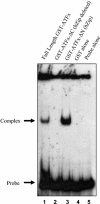The bZIP transcription factor ATFx binds human T-cell leukemia virus type 1 (HTLV-1) Tax and represses HTLV-1 long terminal repeat-mediated transcription
- PMID: 15890932
- PMCID: PMC1112100
- DOI: 10.1128/JVI.79.11.6932-6939.2005
The bZIP transcription factor ATFx binds human T-cell leukemia virus type 1 (HTLV-1) Tax and represses HTLV-1 long terminal repeat-mediated transcription
Abstract
The human T-cell leukemia virus type 1 (HTLV-1) viral protein Tax is a transactivator of transcription driven by the cognate viral long terminal repeat (LTR). Tax exerts its effect through three nonidentical copies of the Tax-responsive element (TxRE), a member of the asymmetric cyclic AMP response element (CRE) family of enhancer sequences. Transactivation is mediated via interaction of Tax with members of the CREB/ATF family bound to TxRE. We have identified a cellular repressor of transcription, activating transcription factor x (ATFx), as a novel Tax-binding protein. In addition to binding directly to Tax we show by electrophoretic mobility shift assay that ATFx binds to the TxRE enhancer element via the bZIP domain. The functional impact of this bridging interaction results in repression of both basal and Tax-induced transcription from the HTLV-1 LTR. ATFx is unique among ATF family of proteins in that it is cell cycle regulated and exerts a tight repressive control over apoptotic signaling. We propose that recruitment of ATFx to the HTLV-1 LTR serves to link viral transcription with critical events in cellular homeostasis.
Figures






Similar articles
-
Protein domains involved in both in vivo and in vitro interactions between human T-cell leukemia virus type I tax and CREB.J Virol. 1995 Jun;69(6):3420-32. doi: 10.1128/JVI.69.6.3420-3432.1995. J Virol. 1995. PMID: 7745688 Free PMC article.
-
Genetic characterization of transactivation of the human T-cell leukemia virus type 1 promoter: Binding of Tax to Tax-responsive element 1 is mediated by the cyclic AMP-responsive members of the CREB/ATF family of transcription factors.Mol Cell Biol. 1996 May;16(5):2174-82. doi: 10.1128/MCB.16.5.2174. Mol Cell Biol. 1996. PMID: 8628284 Free PMC article.
-
Repression of tax-mediated human t-lymphotropic virus type 1 transcription by inducible cAMP early repressor (ICER) protein in peripheral blood mononuclear cells.J Med Virol. 2000 Oct;62(2):286-92. J Med Virol. 2000. PMID: 11002260
-
[Adult T-cell leukemia induced by HTLV-1: before and after HBZ].Med Sci (Paris). 2010 Apr;26(4):391-6. doi: 10.1051/medsci/2010264391. Med Sci (Paris). 2010. PMID: 20412744 Review. French.
-
Human T cell lymphotropic virus type I genomic expression and impact on intracellular signaling pathways during neurodegenerative disease and leukemia.Front Biosci. 2000 Jan 1;5:D138-68. doi: 10.2741/yao. Front Biosci. 2000. PMID: 10702386 Review.
Cited by
-
An activating transcription factor 5-mediated survival pathway as a target for cancer therapy?Oncotarget. 2010 Oct;1(6):457-460. doi: 10.18632/oncotarget.180. Oncotarget. 2010. PMID: 21311102 Free PMC article.
-
The HTLV-1 Tax interactome.Retrovirology. 2008 Aug 14;5:76. doi: 10.1186/1742-4690-5-76. Retrovirology. 2008. PMID: 18702816 Free PMC article. Review.
-
Imaging spontaneous tumorigenesis: inflammation precedes development of peripheral NK tumors.Blood. 2009 Feb 12;113(7):1493-500. doi: 10.1182/blood-2008-07-166462. Epub 2008 Oct 29. Blood. 2009. PMID: 18971418 Free PMC article.
-
Expression of activating transcription factor 5 (ATF5) is mediated by microRNA-520b-3p under diverse cellular stress in cancer cells.PLoS One. 2020 Jun 30;15(6):e0225044. doi: 10.1371/journal.pone.0225044. eCollection 2020. PLoS One. 2020. PMID: 32603335 Free PMC article.
-
Human T-cell leukemia virus type 1 (HTLV-1) bZIP protein interacts with the cellular transcription factor CREB to inhibit HTLV-1 transcription.J Virol. 2007 Feb;81(4):1543-53. doi: 10.1128/JVI.00480-06. Epub 2006 Dec 6. J Virol. 2007. PMID: 17151132 Free PMC article.
References
-
- Alexandre, C., and B. Verrier. 1991. Four regulatory elements in the human c-fos promoter mediate transactivation by HTLV-1 Tax protein. Oncogene 6:543-551. - PubMed
-
- Brauweiler, A., P. Garl, A. A. Franklin, H. A. Giebler, and J. K. Nyborg. 1995. A molecular mechanism for human T-cell leukemia virus latency and Tax transactivation. J. Biol. Chem. 270:12814-12822. - PubMed
Publication types
MeSH terms
Substances
Grants and funding
LinkOut - more resources
Full Text Sources
Molecular Biology Databases
Research Materials

